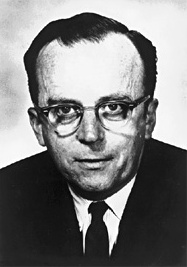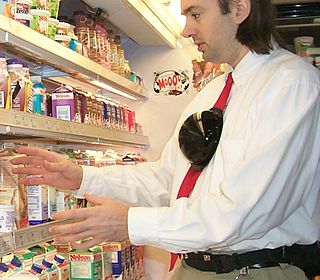Related Research Articles
Ubiquitous computing is a concept in software engineering, hardware engineering and computer science where computing is made to appear seamlessly anytime and everywhere. In contrast to desktop computing, ubiquitous computing implies use on any device, in any location, and in any format. A user interacts with the computer, which can exist in many different forms, including laptop computers, tablets, smart phones and terminals in everyday objects such as a refrigerator or a pair of glasses. The underlying technologies to support ubiquitous computing include the Internet, advanced middleware, operating systems, mobile codes, sensors, microprocessors, new I/Os and user interfaces, computer networks, mobile protocols, global navigational systems, and new materials.

A wearable computer, also known as a body-borne computer, is a computing device worn on the body. The definition of 'wearable computer' may be narrow or broad, extending to smartphones or even ordinary wristwatches.

Joseph Carl Robnett Licklider, known simply as J. C. R. or "Lick", was an American psychologist and computer scientist who is considered to be among the most prominent figures in computer science development and general computing history.

Computer Science and Artificial Intelligence Laboratory (CSAIL) is a research institute at the Massachusetts Institute of Technology (MIT) formed by the 2003 merger of the Laboratory for Computer Science (LCS) and the Artificial Intelligence Laboratory. Housed within the Ray and Maria Stata Center, CSAIL is the largest on-campus laboratory as measured by research scope and membership. It is part of the Schwarzman College of Computing but is also overseen by the MIT Vice President of Research.
Social computing is an area of computer science that is concerned with the intersection of social behavior and computational systems. It is based on creating or recreating social conventions and social contexts through the use of software and technology. Thus, blogs, email, instant messaging, social network services, wikis, social bookmarking and other instances of what is often called social software illustrate ideas from social computing.
Edwin Joseph Selker, better known as Ted Selker, is an American computer scientist known for his user interface inventions.
Michael Leonidas Dertouzos was a professor in the department of Electrical Engineering and Computer Science at the Massachusetts Institute of Technology (MIT) and Director of the MIT Laboratory for Computer Science (LCS) from 1974 to 2001.

Ambient intelligence (AmI) is a term used in computing to refer to electronic environments that are sensitive to the presence of people. The term is generally applied to consumer electronics, telecommunications, and computing.

Smart environments link computers and other smart devices to everyday settings and tasks. Smart environments include smart homes, smart cities, and smart manufacturing.

Rosalind Wright Picard is an American scholar and inventor who is Professor of Media Arts and Sciences at MIT, founder and director of the Affective Computing Research Group at the MIT Media Lab, and co-founder of the startups Affectiva and Empatica.

Paul Dourish is a computer scientist best known for his work and research at the intersection of computer science and social science. Born in Scotland, he holds the Steckler Endowed Chair of Information and Computer Science at the University of California, Irvine, where he joined the faculty in 2000, and where he directs the Steckler Center for Responsible, Ethical, and Accessible Technology. He is a Fellow of the AAAS, the ACM, and the BCS, and is a two-time winner of the ACM CSCW "Lasting Impact" award, in 2016 and 2021.
A pervasive game is one where the gaming experience is extended out into the real world, or where the fictional world in which the game takes place blends with the physical world. The "It's Alive" mobile games company described pervasive games as "games that surround you," while Montola, Stenros, and Waern's book Pervasive Games defines them as having "one or more salient features that expand the contractual magic circle of play spatially, temporally, or socially." The concept of a "magic circle" draws from the work of Johan Huizinga, who describes the boundaries of play.

Anant Agarwal is an Indian computer architecture researcher. He is a professor of Electrical Engineering and Computer Science at the Massachusetts Institute of Technology (MIT), where he led the development of Alewife, an early cache coherent multiprocessor, and also has served as director of the MIT Computer Science and Artificial Intelligence Laboratory. He is the founder and CTO of Tilera, a fabless semiconductor company focusing on scalable multicore embedded processor design. He also serves as the CEO of edX, a joint partnership between MIT and Harvard University that offers free online learning.

SixthSense is a gesture-based wearable computer system developed at MIT Media Lab by Steve Mann in 1994 and 1997, and 1998, and further developed by Pranav Mistry, in 2009, both of whom developed both hardware and software for both headworn and neckworn versions of it. It comprises a headworn or neck-worn pendant that contains both a data projector and camera. Headworn versions were built at MIT Media Lab in 1997 that combined cameras and illumination systems for interactive photographic art, and also included gesture recognition.
The Telecooperation Office (TECO) is a research group at the Karlsruhe Institute of Technology in Karlsruhe, Germany. The research group is in the Institute of Telematics, and is attached to the chair for Pervasive Computing Systems, currently held by Michael Beigl.
Hossein Rahnama is a Canadian computer scientist, specialising in ubiquitous and pervasive computing. His research explores artificial intelligence, mobile human-computer interaction, and the effective design of contextual services. In 2017, Rahnama was included in Caldwell Partners' list of "Canada’s Top 40 Under 40". In 2012, he was recognized by the MIT Technology Review as one of the world’s top innovators under the age of 35 for his research in context-aware computing. The Smithsonian named Rahnama as one of the top six innovators to watch in 2013. Rahnama has 30 publications and 10 patents in ubiquitous computing, serves on the board of Canadian Science Publishing, and was a Council Member of the National Sciences and Engineering Research Council (NSERC). Rahnama is also a visiting scholar at the Human Dynamics group at MIT Media Lab in Cambridge, MA. He has a PhD in Computer Science from Ryerson University. Rahmnama is an associate professor in Toronto Metropolitan University's RTA School of Media and Director of Research & Innovation at the university's Digital Media Zone.
Alice Jane Brush is an American computer scientist known for her research in human-computer interaction, ubiquitous computing and computer supported collaborative work (CSCW). She is particularly known for her research studying and building technology for homes as well as expertise conducting field studies of technology. She is the co-chair of CRA-W from 2014 to 2017.
Urban informatics refers to the study of people creating, applying and using information and communication technology and data in the context of cities and urban environments. It sits at the conjunction of urban science, geomatics, and informatics, with an ultimate goal of creating more smart and sustainable cities. Various definitions are available, some provided in the Definitions section.
Joëlle Coutaz is a French computer scientist, specializing in human-computer interaction (HCI). Her career includes research in the fields of operating systems and HCI, as well as being a professor at the University of Grenoble. Coutaz is considered a pioneer in HCI in France, and in 2007, she was awarded membership to SIGCHI. She was also involved in organizing CHI conferences and was a member on the editorial board of ACM Transactions on Computer-Human Interaction.
Morten Kyng is a Danish computer science researcher and author. He is a member of Association of Computing Machinery's Computer-Human Interaction Academy member. He is a ubiquitous computing professor at Aarhus University. He is a Member of Board of Directors of Østjysk Innovation and the Director of the Centre for Pervasive Healthcare, a research centre that studies the use of pervasive computer technologies to provide healthcare solutions.
References
- ↑ Making computing as easy as breathing: MIT's Project Oxygen research shaping future of technology, Leslie Walker, San Francisco Chronicle, November 22, 2004. Accessed on line November 28, 2007.
- ↑ Project Oxygen: Pervasive, Human-Centric Computing—An Initial Experience, Larry Rudolph, pp. 1–12, in Advanced Information Systems Engineering: 13th International Conference, proceedings, eds. Klaus R. Dittrich, Andreas Geppert, Moira C. Norrie, Springer: 2001, ISBN 3540422153.
- 1 2 Kramsky, Logan (2021-04-19). "Project Oxygen Profile and Critique". Digital Shroud. Retrieved 2024-08-10.